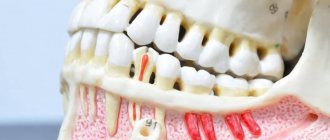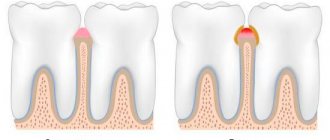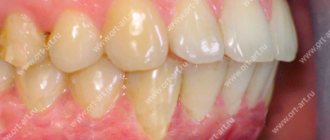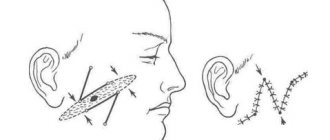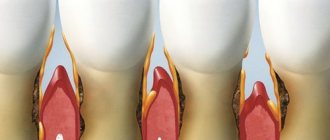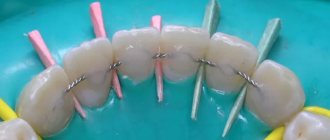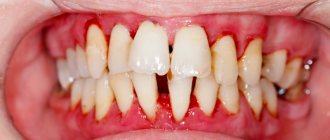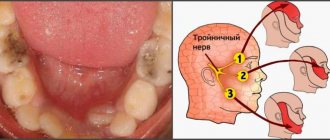Periodontal disease is a set of pathological processes that spread to the tissues surrounding the teeth and holding them in the alveoli. According to statistics, pathologies belonging to this group are diagnosed in 90% of the adult population. Moreover, most often diseases of this type are detected in men and women aged 37-45 years.
In the absence of timely and competent treatment, periodontal diseases can cause loosening and premature tooth loss, the appearance of foci of chronic infection in the oral cavity, deterioration of the body’s immune status and the development of other complications. That is why modern dentists pay increased attention to the development of methods and means for treating pathologies belonging to this group.
Structure and functions of periodontium
Periodontium is usually called a complex of tissues that includes:
- alveolar processes (areas of the jaw that bear the dentition);
- gums (mucous membranes covering the alveolar processes);
- periodontium (tissues consisting of protein fibers and located in the space between the alveolar plate and the cement of the tooth root);
- cement (special bone tissue covering the roots and necks of teeth).
In the human body, the periodontium performs the following functions:
- shock-absorbing (evenly distributes the load on the jaws);
- supporting-retaining (provides strong fixation of the tooth in the alveolar socket);
- trophic (contains an extensive network of lymphatic and blood vessels, a huge number of nerve receptors);
- barrier (protective) and others.
Preserving periodontal tissue in a healthy state is the key to long-term and proper functioning of the masticatory apparatus.
Gingivitis
Gingivitis is an inflammatory disease of the gums that can occur in acute or chronic form. The disease is very common, sometimes patients may not be aware of its existence. Gingivitis occurs due to various reasons and has several forms of manifestation. The pathology is characterized by redness of the marginal edge of the gums, swelling, and pain.
Types of gingivitis
There are several types of diseases. According to the form of the inflammatory process, gingivitis can be acute and chronic, while the chronic form can periodically worsen. If the inflammatory process covers one or more adjacent teeth, then we are talking about a localized form of the disease, but if the process has spread throughout the entire oral cavity, it is a generalized form.
Depending on the type of pathological process, the disease can be catarrhal, ulcerative, atrophic and hypertrophic. The disease can manifest itself in severe or mild form, each type of gingivitis has its own distinctive symptoms and manifestations.
Symptoms of gingivitis
Symptoms of gingivitis will depend on the type and nature of the soft tissue damage.
The catarrhal form of the disease is manifested by redness, swelling, pain and bleeding of the gums. An unpleasant odor, increased temperature, disruption of food intake and distortion of taste sensations may also appear.
Atrophic gingivitis is characterized by inflammation and reduction in the volume of the gums and gingival papillae. Symptoms are unpleasant and painful sensations in the affected area.
Hypertrophic gingivitis is manifested by a significant increase in tissue volume and overlap of tooth crowns. The disease is chronic in nature and has few clinical manifestations.
The ulcerative form of the disease is characterized by the formation of painful ulcers on the gums. In this case, manifestations occur not only in the oral cavity, but also in the body (fever, weakness). This type of gingivitis occurs in people with reduced immunity.
Treatment of gingivitis
Symptoms and treatment of gingivitis will depend on the form of the disease, severity, location and individual manifestations. Therapy should be carried out by a specialist after examination and diagnosis. Treatment of gingivitis consists of the following stages:
Determining and eliminating the cause of the disease;
Professional oral hygiene;
The use of anti-inflammatory drugs (ointments, gels, solutions);
Use of antibacterial therapy;
Taking vitamins and a balanced diet is recommended;
If necessary, surgical interventions are used.
Causes of periodontal disease development
Factors that increase the likelihood of developing periodontal disease are:
- heredity;
- hypovitaminosis;
- failure to comply with hygiene requirements;
- presence of dental plaque;
- dental anomalies (bite disorders and others);
- somatic diseases (malfunctions of the nervous system, gastrointestinal diseases, diabetes mellitus, cardiac and endocrine disorders);
- smoking;
- weakened immune system;
- non-compliance with drinking regime;
- habit of breathing through the mouth;
- the presence in the oral cavity of low-quality fillings, orthodontic or orthopedic structures incorrectly installed in dentistry.
In addition, the risk of disease directly depends on the place of residence, lifestyle, characteristics of professional activity and dietary habits of patients.
Idiopathic diseases with progressive lysis of periodontal tissue
Go back This group of diseases is united by the severity of symptoms. Gingivitis is pronounced, the epithelial-enamel junction is quickly destroyed, the pockets are deep, often with purulent exudate. Rapid resorption of bone tissue and its lysis also occurs.
1. Insulin-dependent diabetes mellitus. It begins to develop with gingivitis. The gums are red and bleeding. Hypertrophic gingivitis often occurs, which progresses to periodontitis. Periodontal pockets form. Teeth become mobile. On the X-ray image, bone tissue resorption is uneven (both crater-shaped and lacunar types are present). There is a certain pattern - the longer patients take insulin, the more periodontitis progresses (the more complicated the situation). People with type 1 diabetes should be registered with a dentist and undergo regular check-ups. Type 2 diabetes is not a risk factor for the development of periodontitis.
2. Taratynov’s disease. The disease affects flat bones. Reticuloendothelial cells form clusters, growing in the bone marrow. Enzymatic processes inside cells are disrupted. This disease can affect both the body and branch isolated from the alveolar process, and all structures simultaneously. There is pain in healthy teeth and bleeding gums. On examination, the development of ulcerative gingivitis, the presence of pockets. High mobility of teeth leads to their loss; the holes take a long time to heal.
An X-ray will show the following picture: foci of destruction of irregular shape with corroded contours. Children under 6 years of age are more likely to develop eosinophilic granuloma. The diagnosis is made according to histology. A blood test will show leukocytosis and eosinophilia.
3. Hand-Schueller-Christian disease. Characterized by a disorder of cholesterol metabolism. Foci of cells—sedentary macrophages—are formed in the bone marrow, lymph nodes, and internal organs. These cells are characterized by an increased content of lipids in the cytoplasm. The disease begins with loss of appetite, weight loss, and general fatigue. Further, papular rashes appear on the chest, on the scalp, and in areas behind the ears. Ulcerative-nekotic gingivitis develops in the oral cavity, granulations grow from periodontal pockets, and teeth are mobile. The radiograph shows bone destruction of the lacunar type. The alveolar process, body and ascending branch of the mandible are affected. The so-called Christian triad is known - diabetes insipidus, exophthalmos, foci of destruction of flat bones.
Histological examination shows the presence of xanthoma cells in bone marrow and spleen punctates. Blood tests show leukocytosis, decreased hemoglobin levels.
4. Letterer-Siwe disease.
Main symptoms:
- heat;
- diarrhea;
- increased fluid intake (constant feeling of thirst). Upon examination - enlarged lymph nodes, the presence of rashes on the body.
Hepato and splenomegaly.
Acute periodontitis. Ulcerative gingivitis begins and progresses rapidly. The epithelial-enamel barrier is destroyed, pockets are formed. For x-ray. The image shows areas of damage (lacunar type) of the alveolar process, body and branch. Histology will show proliferation of reticuloendothelial cells in the biopsy material. Blood tests show an increase in eosinophils, platelets, and a decrease in hemoglobin.
For consultations at the KIITOS dental clinic, please contact the administrators.
Symptoms of periodontal disease
The first symptoms indicating the occurrence of periodontal disease are:
- tingling, itching, numbness in the gums;
- bleeding of gum tissue;
- swelling of the interdental papillae;
- thickening of the gingival margin;
- detachment of gums from dental crowns.
In the future, the clinical picture may be supplemented by:
- gradual exposure of the necks of the teeth;
- redness, hyperemia of the gums;
- formation of pathological gum pockets;
- increase in interdental spaces;
- gradual loosening of teeth.
Symptoms of tissue diseases also include increased sensitivity of dental tissues to irritants, as well as aching pain in the affected area.
Types of diseases
>
Inflammatory gum diseases can be of several types:
Papillitis - inflammation of the interdental papilla;
Gingivitis is inflammation of the soft tissues of the gums without disruption of the periodontal junction;
Periodontitis is inflammation of the periodontium - all the tissues that surround and hold the tooth in the bone;
Periodontal disease is a dystrophic-inflammatory disease of soft tissues, which is characterized by tissue atrophy and causes tooth loss;
Idiopathic periodontal diseases, which are accompanied by tissue lysis;
Periodontomas – the appearance of neoplasms and tumor-like processes in the periodontium;
Flux (fistula) is a formation on the gum that occurs as a result of chronic periodontitis and through which purulent contents come out.
Treatment of periodontal diseases
The general treatment program for periodontal diseases includes:
- removal of microbial plaque and mineralized deposits from the surface of teeth;
- caries therapy;
- preventing functional overload of certain areas of the dentition;
- rejection of bad habits;
- carrying out orthodontic treatment (if indicated);
- anti-inflammatory therapy;
- combating systemic diseases;
- the use of drugs that enhance immunity, stimulate osteogenesis and activate the adaptive and protective functions of the body;
- carrying out general hygiene measures (monitoring the regime of work, nutrition, rest, hygiene).
The treatment regimen for periodontal diseases is drawn up taking into account all manifestations of the disease and the results of a comprehensive examination of the patient. Timely seeking of professional help by a patient significantly improves the prognosis of the disease, shortens the duration of treatment and avoids the development of complications.
Treatment
Depending on the cause of the disease, professional therapy includes the following treatment methods:
1. Removal of dental plaque using ultrasound and Air-flow device. This stage of treatment is the main one and is carried out first. Eliminate subgingival and supragingival tartar, plaque, soft and hard plaque, pigmentation;
2. Treatment of a fistula on the gum includes treatment of root canals and elimination of the root cause of the disease. After eliminating inflammation at the root apex, the fistula heals on its own;
3. Treatment of gum inflammation using anti-inflammatory drugs in the form of pastes, gels, solutions;
4. Antiviral agents are used for herpetic tissue damage;
5. Antimicrobial drugs are prescribed for the formation of ulcers, erosions and other elements of lesions on the gums;
6. Wound healing medications are necessary in the presence of ulcers or necrotic changes in the mucous membrane;
7. General restorative therapy includes immunostimulating agents and vitamins;
8. Consultation and treatment with other specialists (general practitioner, endocrinologist, gastroenterologist, etc.).

